Corporate Finance
VerifiedAdded on 2022/11/28
|16
|3972
|435
AI Summary
This document provides an overview of corporate finance, focusing on the objectives of maximizing shareholder wealth, sources of finance, factors considered in choosing finance sources, and the calculation of weighted average cost of capital. It discusses the case of Tenaga Nasional Berhad, a Malaysian electricity company, and its financial structure. Find study material and solved assignments on corporate finance at Desklib.
Contribute Materials
Your contribution can guide someone’s learning journey. Share your
documents today.
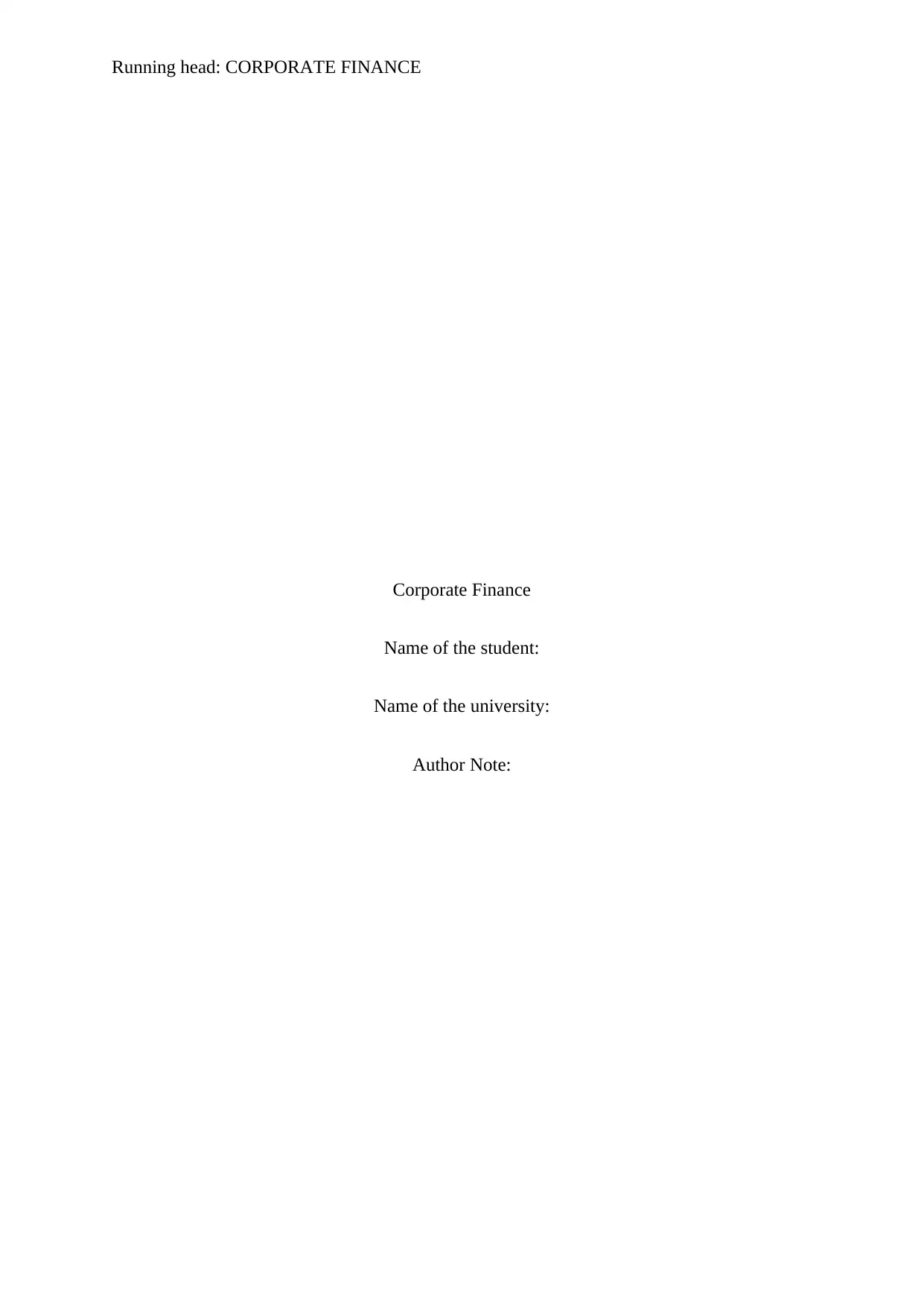
Running head: CORPORATE FINANCE
Corporate Finance
Name of the student:
Name of the university:
Author Note:
Corporate Finance
Name of the student:
Name of the university:
Author Note:
Secure Best Marks with AI Grader
Need help grading? Try our AI Grader for instant feedback on your assignments.
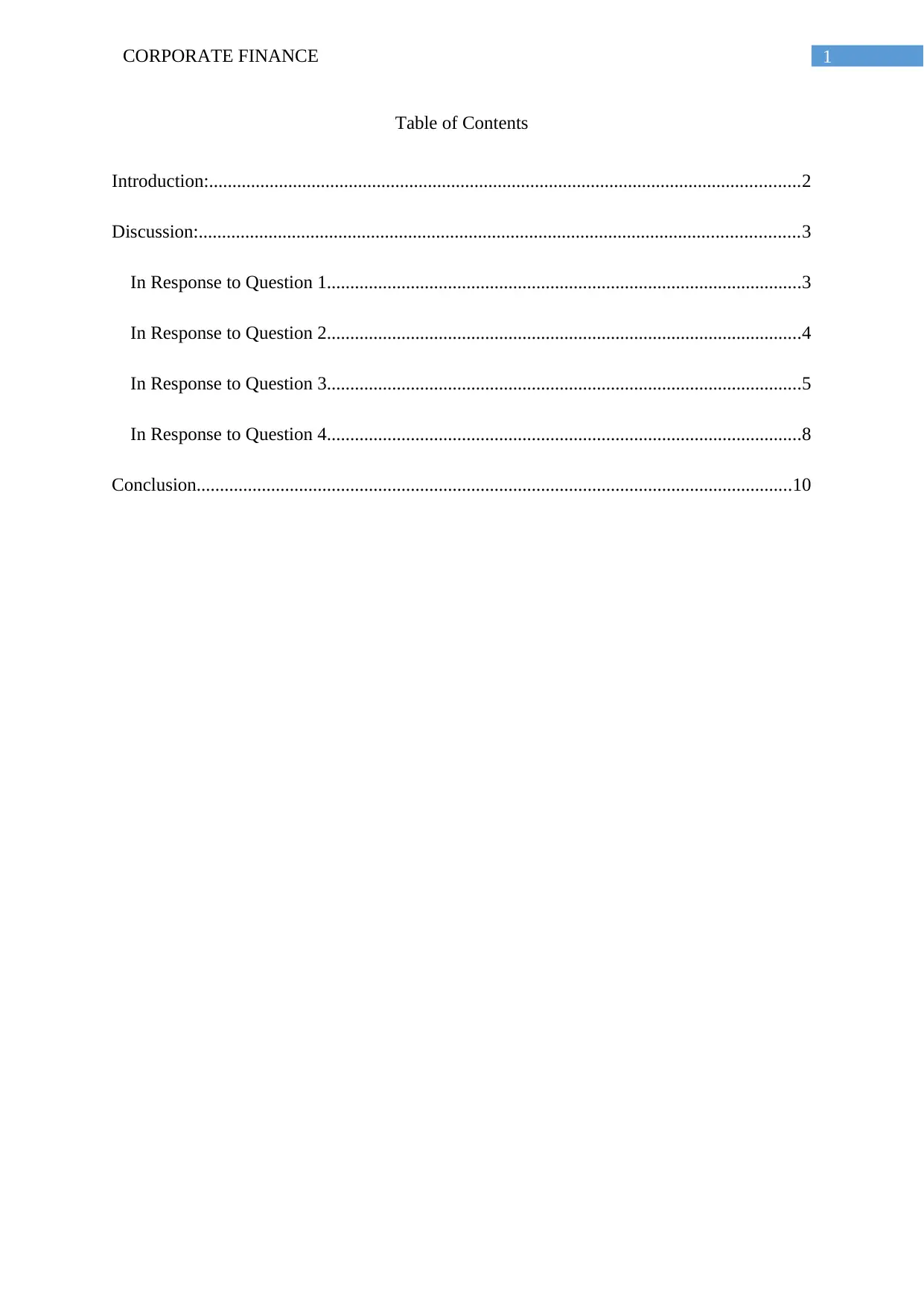
1CORPORATE FINANCE
Table of Contents
Introduction:...............................................................................................................................2
Discussion:.................................................................................................................................3
In Response to Question 1......................................................................................................3
In Response to Question 2......................................................................................................4
In Response to Question 3......................................................................................................5
In Response to Question 4......................................................................................................8
Conclusion................................................................................................................................10
Table of Contents
Introduction:...............................................................................................................................2
Discussion:.................................................................................................................................3
In Response to Question 1......................................................................................................3
In Response to Question 2......................................................................................................4
In Response to Question 3......................................................................................................5
In Response to Question 4......................................................................................................8
Conclusion................................................................................................................................10
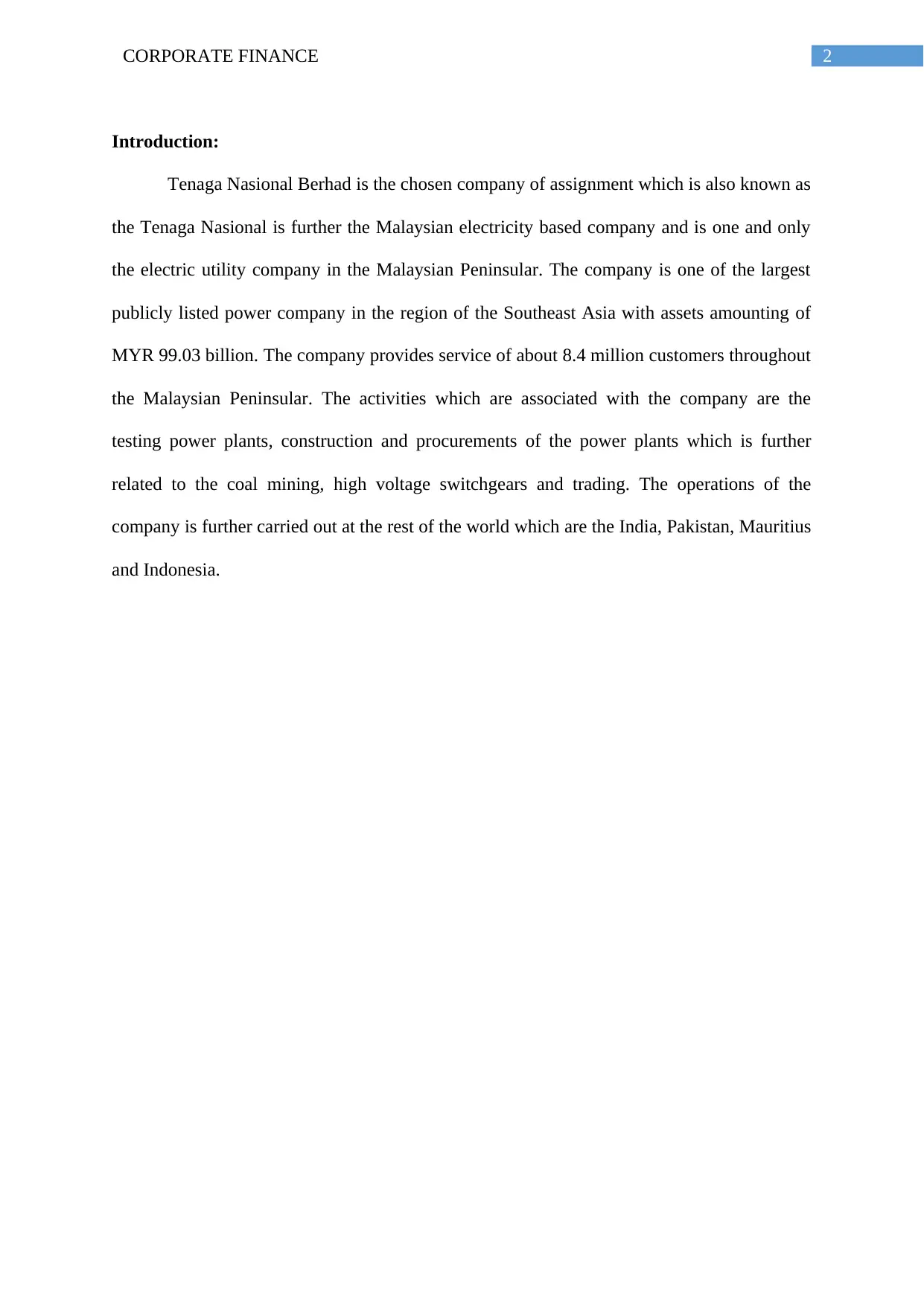
2CORPORATE FINANCE
Introduction:
Tenaga Nasional Berhad is the chosen company of assignment which is also known as
the Tenaga Nasional is further the Malaysian electricity based company and is one and only
the electric utility company in the Malaysian Peninsular. The company is one of the largest
publicly listed power company in the region of the Southeast Asia with assets amounting of
MYR 99.03 billion. The company provides service of about 8.4 million customers throughout
the Malaysian Peninsular. The activities which are associated with the company are the
testing power plants, construction and procurements of the power plants which is further
related to the coal mining, high voltage switchgears and trading. The operations of the
company is further carried out at the rest of the world which are the India, Pakistan, Mauritius
and Indonesia.
Introduction:
Tenaga Nasional Berhad is the chosen company of assignment which is also known as
the Tenaga Nasional is further the Malaysian electricity based company and is one and only
the electric utility company in the Malaysian Peninsular. The company is one of the largest
publicly listed power company in the region of the Southeast Asia with assets amounting of
MYR 99.03 billion. The company provides service of about 8.4 million customers throughout
the Malaysian Peninsular. The activities which are associated with the company are the
testing power plants, construction and procurements of the power plants which is further
related to the coal mining, high voltage switchgears and trading. The operations of the
company is further carried out at the rest of the world which are the India, Pakistan, Mauritius
and Indonesia.
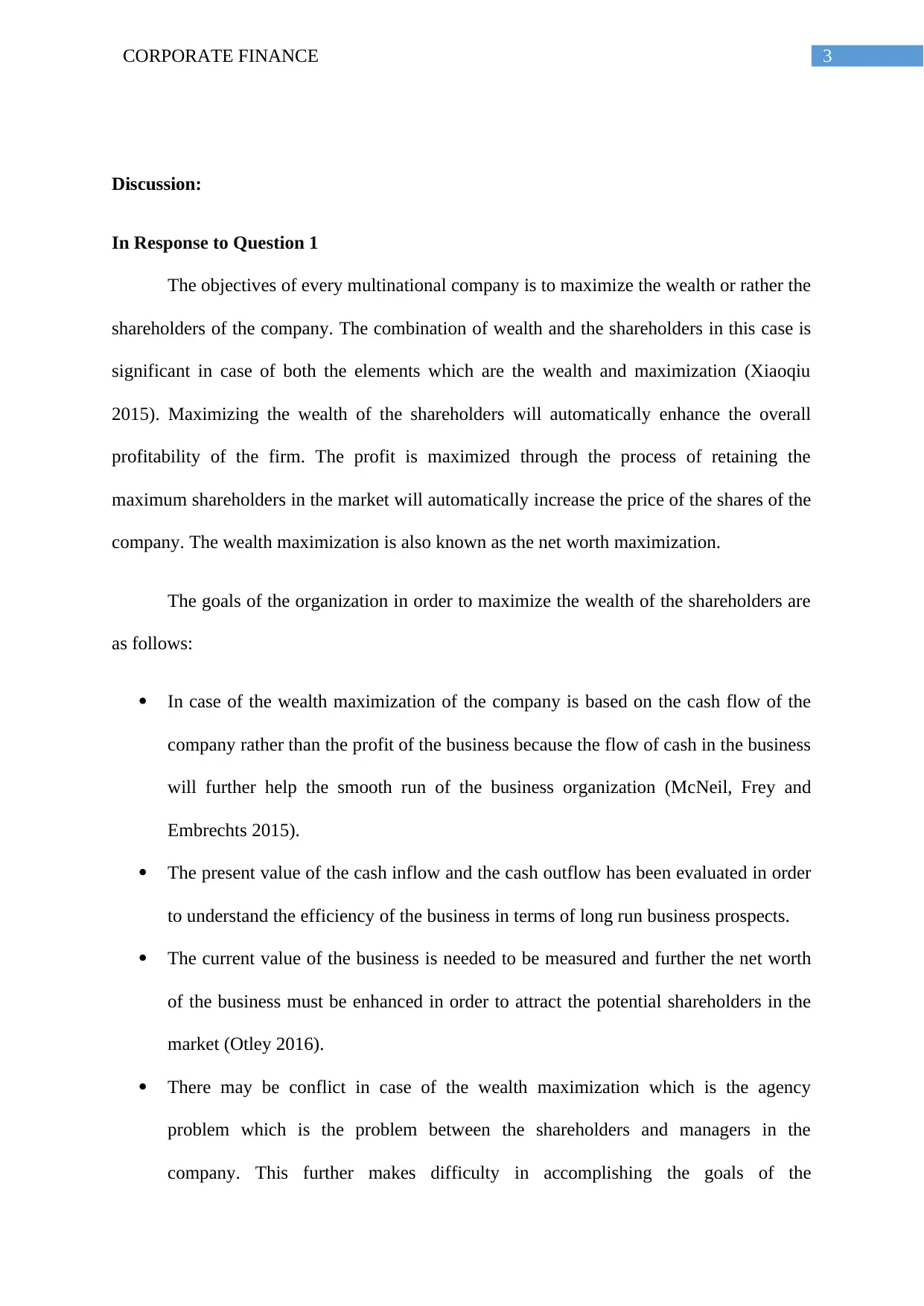
3CORPORATE FINANCE
Discussion:
In Response to Question 1
The objectives of every multinational company is to maximize the wealth or rather the
shareholders of the company. The combination of wealth and the shareholders in this case is
significant in case of both the elements which are the wealth and maximization (Xiaoqiu
2015). Maximizing the wealth of the shareholders will automatically enhance the overall
profitability of the firm. The profit is maximized through the process of retaining the
maximum shareholders in the market will automatically increase the price of the shares of the
company. The wealth maximization is also known as the net worth maximization.
The goals of the organization in order to maximize the wealth of the shareholders are
as follows:
In case of the wealth maximization of the company is based on the cash flow of the
company rather than the profit of the business because the flow of cash in the business
will further help the smooth run of the business organization (McNeil, Frey and
Embrechts 2015).
The present value of the cash inflow and the cash outflow has been evaluated in order
to understand the efficiency of the business in terms of long run business prospects.
The current value of the business is needed to be measured and further the net worth
of the business must be enhanced in order to attract the potential shareholders in the
market (Otley 2016).
There may be conflict in case of the wealth maximization which is the agency
problem which is the problem between the shareholders and managers in the
company. This further makes difficulty in accomplishing the goals of the
Discussion:
In Response to Question 1
The objectives of every multinational company is to maximize the wealth or rather the
shareholders of the company. The combination of wealth and the shareholders in this case is
significant in case of both the elements which are the wealth and maximization (Xiaoqiu
2015). Maximizing the wealth of the shareholders will automatically enhance the overall
profitability of the firm. The profit is maximized through the process of retaining the
maximum shareholders in the market will automatically increase the price of the shares of the
company. The wealth maximization is also known as the net worth maximization.
The goals of the organization in order to maximize the wealth of the shareholders are
as follows:
In case of the wealth maximization of the company is based on the cash flow of the
company rather than the profit of the business because the flow of cash in the business
will further help the smooth run of the business organization (McNeil, Frey and
Embrechts 2015).
The present value of the cash inflow and the cash outflow has been evaluated in order
to understand the efficiency of the business in terms of long run business prospects.
The current value of the business is needed to be measured and further the net worth
of the business must be enhanced in order to attract the potential shareholders in the
market (Otley 2016).
There may be conflict in case of the wealth maximization which is the agency
problem which is the problem between the shareholders and managers in the
company. This further makes difficulty in accomplishing the goals of the
Secure Best Marks with AI Grader
Need help grading? Try our AI Grader for instant feedback on your assignments.
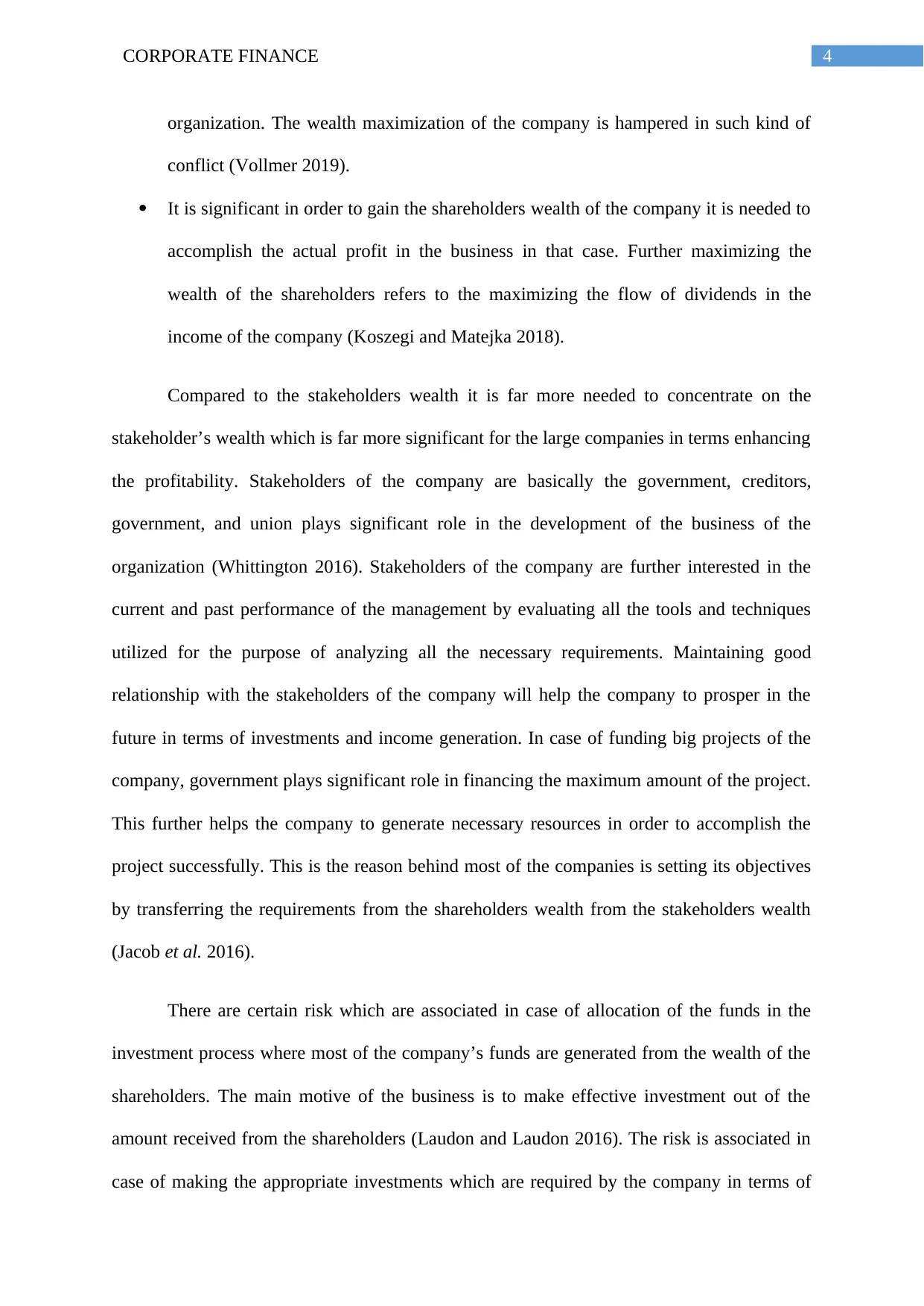
4CORPORATE FINANCE
organization. The wealth maximization of the company is hampered in such kind of
conflict (Vollmer 2019).
It is significant in order to gain the shareholders wealth of the company it is needed to
accomplish the actual profit in the business in that case. Further maximizing the
wealth of the shareholders refers to the maximizing the flow of dividends in the
income of the company (Koszegi and Matejka 2018).
Compared to the stakeholders wealth it is far more needed to concentrate on the
stakeholder’s wealth which is far more significant for the large companies in terms enhancing
the profitability. Stakeholders of the company are basically the government, creditors,
government, and union plays significant role in the development of the business of the
organization (Whittington 2016). Stakeholders of the company are further interested in the
current and past performance of the management by evaluating all the tools and techniques
utilized for the purpose of analyzing all the necessary requirements. Maintaining good
relationship with the stakeholders of the company will help the company to prosper in the
future in terms of investments and income generation. In case of funding big projects of the
company, government plays significant role in financing the maximum amount of the project.
This further helps the company to generate necessary resources in order to accomplish the
project successfully. This is the reason behind most of the companies is setting its objectives
by transferring the requirements from the shareholders wealth from the stakeholders wealth
(Jacob et al. 2016).
There are certain risk which are associated in case of allocation of the funds in the
investment process where most of the company’s funds are generated from the wealth of the
shareholders. The main motive of the business is to make effective investment out of the
amount received from the shareholders (Laudon and Laudon 2016). The risk is associated in
case of making the appropriate investments which are required by the company in terms of
organization. The wealth maximization of the company is hampered in such kind of
conflict (Vollmer 2019).
It is significant in order to gain the shareholders wealth of the company it is needed to
accomplish the actual profit in the business in that case. Further maximizing the
wealth of the shareholders refers to the maximizing the flow of dividends in the
income of the company (Koszegi and Matejka 2018).
Compared to the stakeholders wealth it is far more needed to concentrate on the
stakeholder’s wealth which is far more significant for the large companies in terms enhancing
the profitability. Stakeholders of the company are basically the government, creditors,
government, and union plays significant role in the development of the business of the
organization (Whittington 2016). Stakeholders of the company are further interested in the
current and past performance of the management by evaluating all the tools and techniques
utilized for the purpose of analyzing all the necessary requirements. Maintaining good
relationship with the stakeholders of the company will help the company to prosper in the
future in terms of investments and income generation. In case of funding big projects of the
company, government plays significant role in financing the maximum amount of the project.
This further helps the company to generate necessary resources in order to accomplish the
project successfully. This is the reason behind most of the companies is setting its objectives
by transferring the requirements from the shareholders wealth from the stakeholders wealth
(Jacob et al. 2016).
There are certain risk which are associated in case of allocation of the funds in the
investment process where most of the company’s funds are generated from the wealth of the
shareholders. The main motive of the business is to make effective investment out of the
amount received from the shareholders (Laudon and Laudon 2016). The risk is associated in
case of making the appropriate investments which are required by the company in terms of
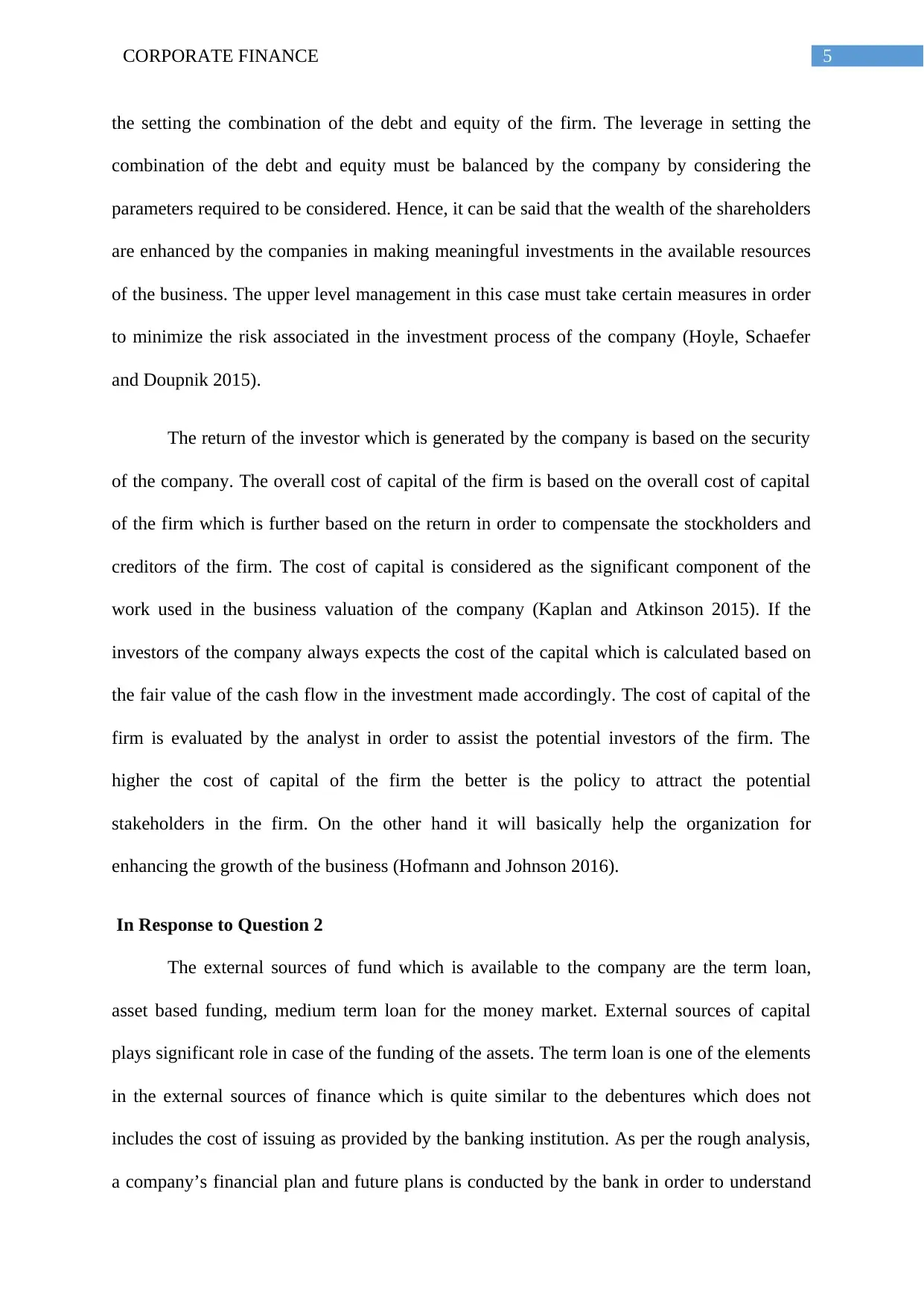
5CORPORATE FINANCE
the setting the combination of the debt and equity of the firm. The leverage in setting the
combination of the debt and equity must be balanced by the company by considering the
parameters required to be considered. Hence, it can be said that the wealth of the shareholders
are enhanced by the companies in making meaningful investments in the available resources
of the business. The upper level management in this case must take certain measures in order
to minimize the risk associated in the investment process of the company (Hoyle, Schaefer
and Doupnik 2015).
The return of the investor which is generated by the company is based on the security
of the company. The overall cost of capital of the firm is based on the overall cost of capital
of the firm which is further based on the return in order to compensate the stockholders and
creditors of the firm. The cost of capital is considered as the significant component of the
work used in the business valuation of the company (Kaplan and Atkinson 2015). If the
investors of the company always expects the cost of the capital which is calculated based on
the fair value of the cash flow in the investment made accordingly. The cost of capital of the
firm is evaluated by the analyst in order to assist the potential investors of the firm. The
higher the cost of capital of the firm the better is the policy to attract the potential
stakeholders in the firm. On the other hand it will basically help the organization for
enhancing the growth of the business (Hofmann and Johnson 2016).
In Response to Question 2
The external sources of fund which is available to the company are the term loan,
asset based funding, medium term loan for the money market. External sources of capital
plays significant role in case of the funding of the assets. The term loan is one of the elements
in the external sources of finance which is quite similar to the debentures which does not
includes the cost of issuing as provided by the banking institution. As per the rough analysis,
a company’s financial plan and future plans is conducted by the bank in order to understand
the setting the combination of the debt and equity of the firm. The leverage in setting the
combination of the debt and equity must be balanced by the company by considering the
parameters required to be considered. Hence, it can be said that the wealth of the shareholders
are enhanced by the companies in making meaningful investments in the available resources
of the business. The upper level management in this case must take certain measures in order
to minimize the risk associated in the investment process of the company (Hoyle, Schaefer
and Doupnik 2015).
The return of the investor which is generated by the company is based on the security
of the company. The overall cost of capital of the firm is based on the overall cost of capital
of the firm which is further based on the return in order to compensate the stockholders and
creditors of the firm. The cost of capital is considered as the significant component of the
work used in the business valuation of the company (Kaplan and Atkinson 2015). If the
investors of the company always expects the cost of the capital which is calculated based on
the fair value of the cash flow in the investment made accordingly. The cost of capital of the
firm is evaluated by the analyst in order to assist the potential investors of the firm. The
higher the cost of capital of the firm the better is the policy to attract the potential
stakeholders in the firm. On the other hand it will basically help the organization for
enhancing the growth of the business (Hofmann and Johnson 2016).
In Response to Question 2
The external sources of fund which is available to the company are the term loan,
asset based funding, medium term loan for the money market. External sources of capital
plays significant role in case of the funding of the assets. The term loan is one of the elements
in the external sources of finance which is quite similar to the debentures which does not
includes the cost of issuing as provided by the banking institution. As per the rough analysis,
a company’s financial plan and future plans is conducted by the bank in order to understand
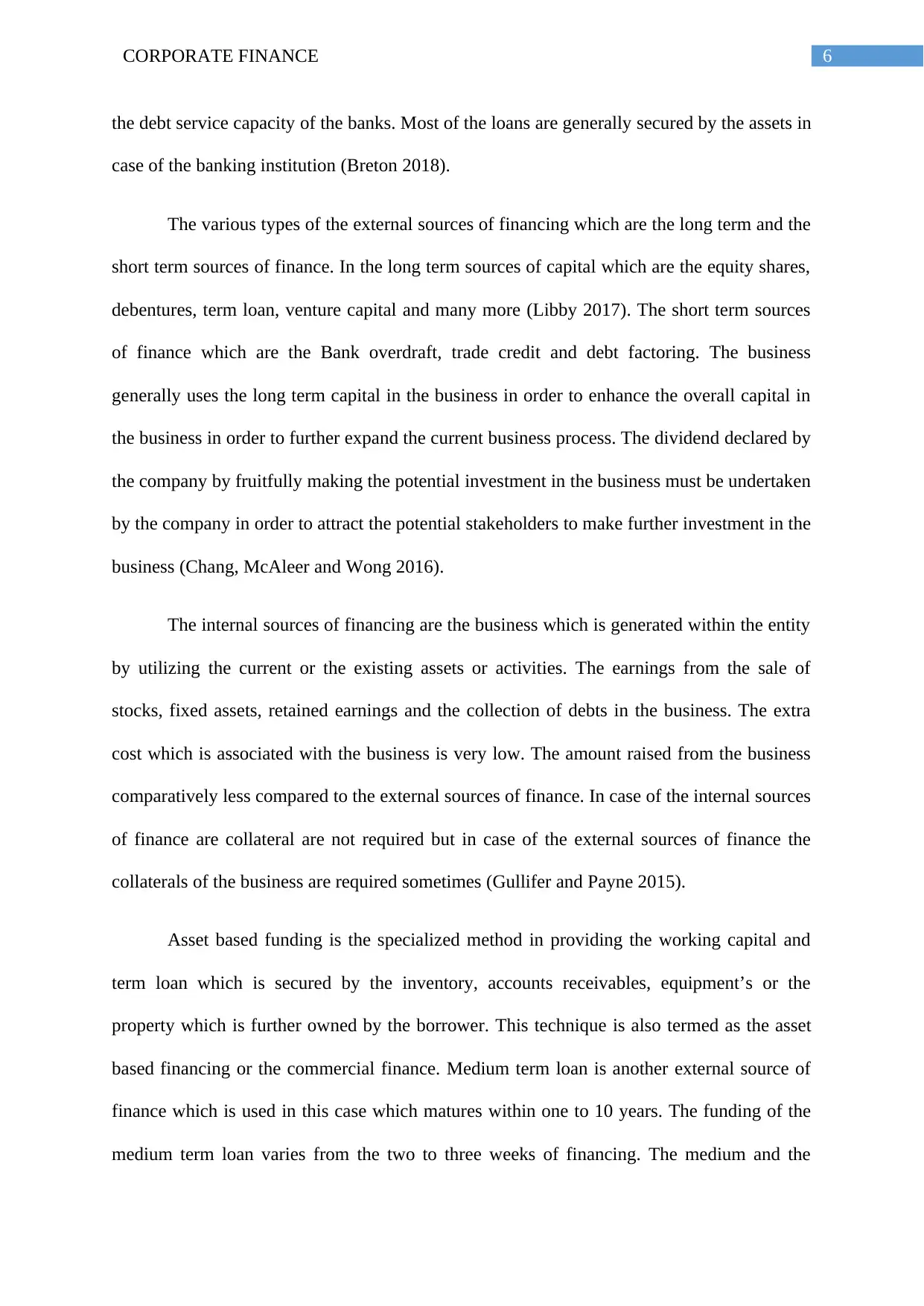
6CORPORATE FINANCE
the debt service capacity of the banks. Most of the loans are generally secured by the assets in
case of the banking institution (Breton 2018).
The various types of the external sources of financing which are the long term and the
short term sources of finance. In the long term sources of capital which are the equity shares,
debentures, term loan, venture capital and many more (Libby 2017). The short term sources
of finance which are the Bank overdraft, trade credit and debt factoring. The business
generally uses the long term capital in the business in order to enhance the overall capital in
the business in order to further expand the current business process. The dividend declared by
the company by fruitfully making the potential investment in the business must be undertaken
by the company in order to attract the potential stakeholders to make further investment in the
business (Chang, McAleer and Wong 2016).
The internal sources of financing are the business which is generated within the entity
by utilizing the current or the existing assets or activities. The earnings from the sale of
stocks, fixed assets, retained earnings and the collection of debts in the business. The extra
cost which is associated with the business is very low. The amount raised from the business
comparatively less compared to the external sources of finance. In case of the internal sources
of finance are collateral are not required but in case of the external sources of finance the
collaterals of the business are required sometimes (Gullifer and Payne 2015).
Asset based funding is the specialized method in providing the working capital and
term loan which is secured by the inventory, accounts receivables, equipment’s or the
property which is further owned by the borrower. This technique is also termed as the asset
based financing or the commercial finance. Medium term loan is another external source of
finance which is used in this case which matures within one to 10 years. The funding of the
medium term loan varies from the two to three weeks of financing. The medium and the
the debt service capacity of the banks. Most of the loans are generally secured by the assets in
case of the banking institution (Breton 2018).
The various types of the external sources of financing which are the long term and the
short term sources of finance. In the long term sources of capital which are the equity shares,
debentures, term loan, venture capital and many more (Libby 2017). The short term sources
of finance which are the Bank overdraft, trade credit and debt factoring. The business
generally uses the long term capital in the business in order to enhance the overall capital in
the business in order to further expand the current business process. The dividend declared by
the company by fruitfully making the potential investment in the business must be undertaken
by the company in order to attract the potential stakeholders to make further investment in the
business (Chang, McAleer and Wong 2016).
The internal sources of financing are the business which is generated within the entity
by utilizing the current or the existing assets or activities. The earnings from the sale of
stocks, fixed assets, retained earnings and the collection of debts in the business. The extra
cost which is associated with the business is very low. The amount raised from the business
comparatively less compared to the external sources of finance. In case of the internal sources
of finance are collateral are not required but in case of the external sources of finance the
collaterals of the business are required sometimes (Gullifer and Payne 2015).
Asset based funding is the specialized method in providing the working capital and
term loan which is secured by the inventory, accounts receivables, equipment’s or the
property which is further owned by the borrower. This technique is also termed as the asset
based financing or the commercial finance. Medium term loan is another external source of
finance which is used in this case which matures within one to 10 years. The funding of the
medium term loan varies from the two to three weeks of financing. The medium and the
Paraphrase This Document
Need a fresh take? Get an instant paraphrase of this document with our AI Paraphraser
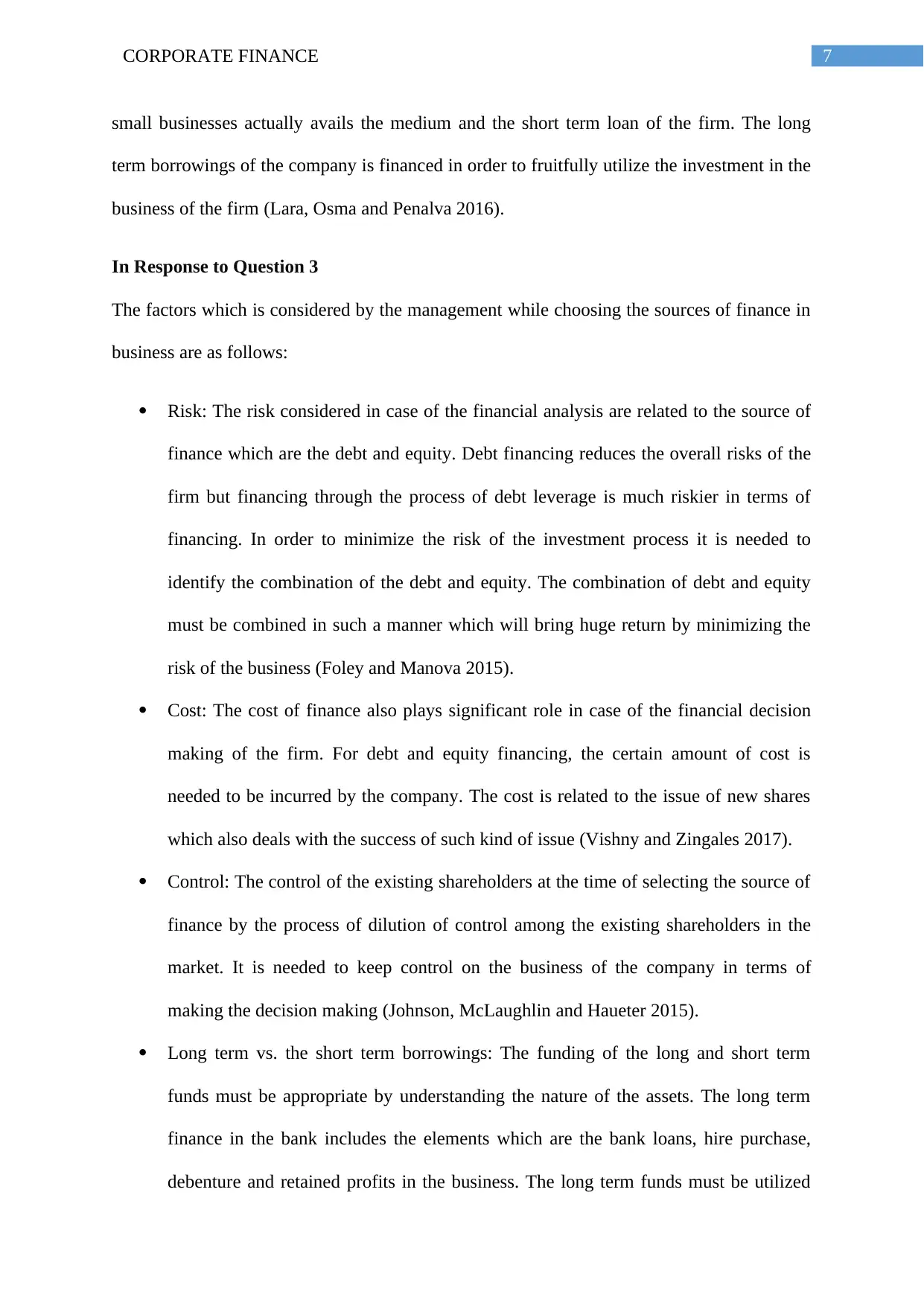
7CORPORATE FINANCE
small businesses actually avails the medium and the short term loan of the firm. The long
term borrowings of the company is financed in order to fruitfully utilize the investment in the
business of the firm (Lara, Osma and Penalva 2016).
In Response to Question 3
The factors which is considered by the management while choosing the sources of finance in
business are as follows:
Risk: The risk considered in case of the financial analysis are related to the source of
finance which are the debt and equity. Debt financing reduces the overall risks of the
firm but financing through the process of debt leverage is much riskier in terms of
financing. In order to minimize the risk of the investment process it is needed to
identify the combination of the debt and equity. The combination of debt and equity
must be combined in such a manner which will bring huge return by minimizing the
risk of the business (Foley and Manova 2015).
Cost: The cost of finance also plays significant role in case of the financial decision
making of the firm. For debt and equity financing, the certain amount of cost is
needed to be incurred by the company. The cost is related to the issue of new shares
which also deals with the success of such kind of issue (Vishny and Zingales 2017).
Control: The control of the existing shareholders at the time of selecting the source of
finance by the process of dilution of control among the existing shareholders in the
market. It is needed to keep control on the business of the company in terms of
making the decision making (Johnson, McLaughlin and Haueter 2015).
Long term vs. the short term borrowings: The funding of the long and short term
funds must be appropriate by understanding the nature of the assets. The long term
finance in the bank includes the elements which are the bank loans, hire purchase,
debenture and retained profits in the business. The long term funds must be utilized
small businesses actually avails the medium and the short term loan of the firm. The long
term borrowings of the company is financed in order to fruitfully utilize the investment in the
business of the firm (Lara, Osma and Penalva 2016).
In Response to Question 3
The factors which is considered by the management while choosing the sources of finance in
business are as follows:
Risk: The risk considered in case of the financial analysis are related to the source of
finance which are the debt and equity. Debt financing reduces the overall risks of the
firm but financing through the process of debt leverage is much riskier in terms of
financing. In order to minimize the risk of the investment process it is needed to
identify the combination of the debt and equity. The combination of debt and equity
must be combined in such a manner which will bring huge return by minimizing the
risk of the business (Foley and Manova 2015).
Cost: The cost of finance also plays significant role in case of the financial decision
making of the firm. For debt and equity financing, the certain amount of cost is
needed to be incurred by the company. The cost is related to the issue of new shares
which also deals with the success of such kind of issue (Vishny and Zingales 2017).
Control: The control of the existing shareholders at the time of selecting the source of
finance by the process of dilution of control among the existing shareholders in the
market. It is needed to keep control on the business of the company in terms of
making the decision making (Johnson, McLaughlin and Haueter 2015).
Long term vs. the short term borrowings: The funding of the long and short term
funds must be appropriate by understanding the nature of the assets. The long term
finance in the bank includes the elements which are the bank loans, hire purchase,
debenture and retained profits in the business. The long term funds must be utilized
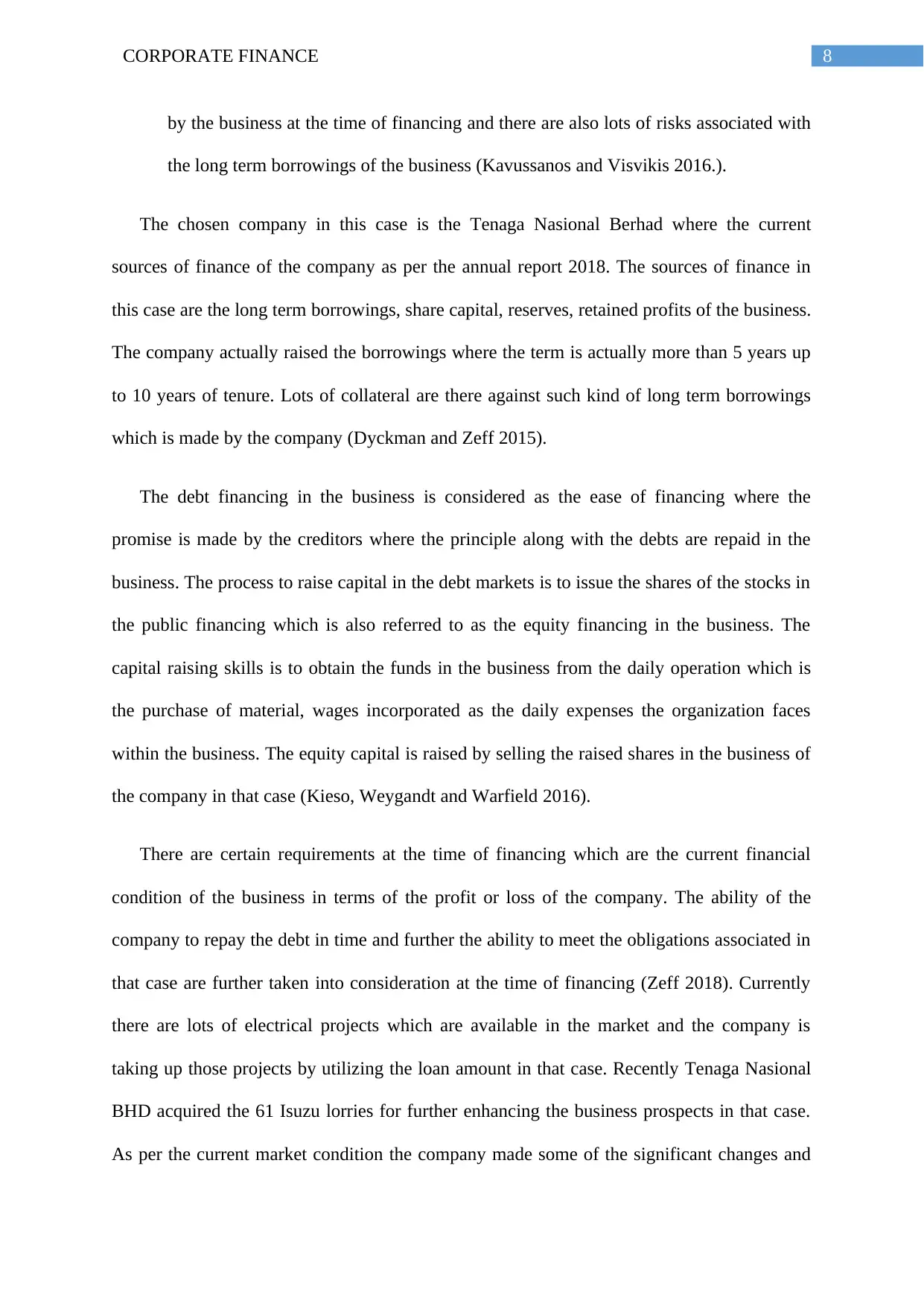
8CORPORATE FINANCE
by the business at the time of financing and there are also lots of risks associated with
the long term borrowings of the business (Kavussanos and Visvikis 2016.).
The chosen company in this case is the Tenaga Nasional Berhad where the current
sources of finance of the company as per the annual report 2018. The sources of finance in
this case are the long term borrowings, share capital, reserves, retained profits of the business.
The company actually raised the borrowings where the term is actually more than 5 years up
to 10 years of tenure. Lots of collateral are there against such kind of long term borrowings
which is made by the company (Dyckman and Zeff 2015).
The debt financing in the business is considered as the ease of financing where the
promise is made by the creditors where the principle along with the debts are repaid in the
business. The process to raise capital in the debt markets is to issue the shares of the stocks in
the public financing which is also referred to as the equity financing in the business. The
capital raising skills is to obtain the funds in the business from the daily operation which is
the purchase of material, wages incorporated as the daily expenses the organization faces
within the business. The equity capital is raised by selling the raised shares in the business of
the company in that case (Kieso, Weygandt and Warfield 2016).
There are certain requirements at the time of financing which are the current financial
condition of the business in terms of the profit or loss of the company. The ability of the
company to repay the debt in time and further the ability to meet the obligations associated in
that case are further taken into consideration at the time of financing (Zeff 2018). Currently
there are lots of electrical projects which are available in the market and the company is
taking up those projects by utilizing the loan amount in that case. Recently Tenaga Nasional
BHD acquired the 61 Isuzu lorries for further enhancing the business prospects in that case.
As per the current market condition the company made some of the significant changes and
by the business at the time of financing and there are also lots of risks associated with
the long term borrowings of the business (Kavussanos and Visvikis 2016.).
The chosen company in this case is the Tenaga Nasional Berhad where the current
sources of finance of the company as per the annual report 2018. The sources of finance in
this case are the long term borrowings, share capital, reserves, retained profits of the business.
The company actually raised the borrowings where the term is actually more than 5 years up
to 10 years of tenure. Lots of collateral are there against such kind of long term borrowings
which is made by the company (Dyckman and Zeff 2015).
The debt financing in the business is considered as the ease of financing where the
promise is made by the creditors where the principle along with the debts are repaid in the
business. The process to raise capital in the debt markets is to issue the shares of the stocks in
the public financing which is also referred to as the equity financing in the business. The
capital raising skills is to obtain the funds in the business from the daily operation which is
the purchase of material, wages incorporated as the daily expenses the organization faces
within the business. The equity capital is raised by selling the raised shares in the business of
the company in that case (Kieso, Weygandt and Warfield 2016).
There are certain requirements at the time of financing which are the current financial
condition of the business in terms of the profit or loss of the company. The ability of the
company to repay the debt in time and further the ability to meet the obligations associated in
that case are further taken into consideration at the time of financing (Zeff 2018). Currently
there are lots of electrical projects which are available in the market and the company is
taking up those projects by utilizing the loan amount in that case. Recently Tenaga Nasional
BHD acquired the 61 Isuzu lorries for further enhancing the business prospects in that case.
As per the current market condition the company made some of the significant changes and
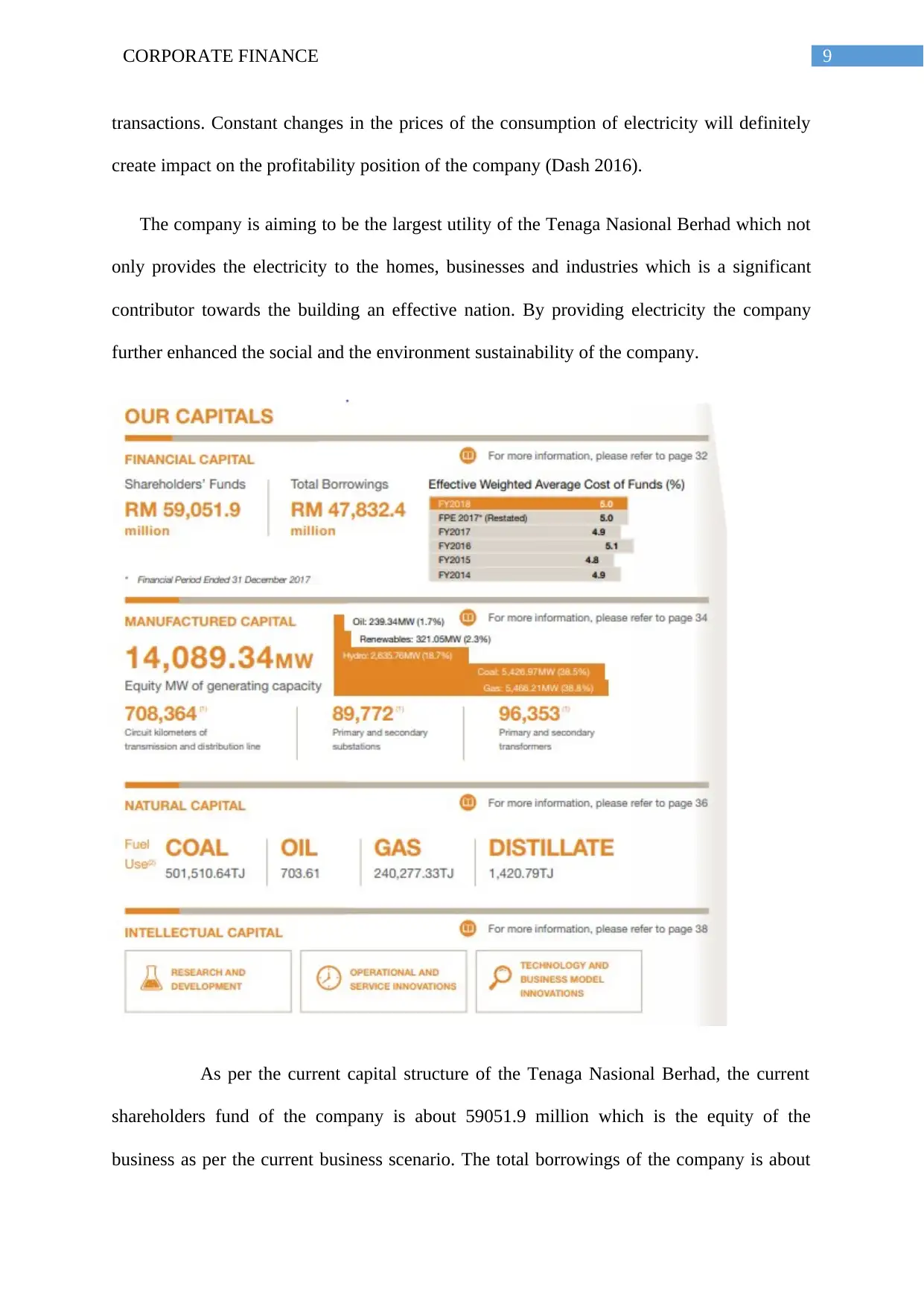
9CORPORATE FINANCE
transactions. Constant changes in the prices of the consumption of electricity will definitely
create impact on the profitability position of the company (Dash 2016).
The company is aiming to be the largest utility of the Tenaga Nasional Berhad which not
only provides the electricity to the homes, businesses and industries which is a significant
contributor towards the building an effective nation. By providing electricity the company
further enhanced the social and the environment sustainability of the company.
As per the current capital structure of the Tenaga Nasional Berhad, the current
shareholders fund of the company is about 59051.9 million which is the equity of the
business as per the current business scenario. The total borrowings of the company is about
transactions. Constant changes in the prices of the consumption of electricity will definitely
create impact on the profitability position of the company (Dash 2016).
The company is aiming to be the largest utility of the Tenaga Nasional Berhad which not
only provides the electricity to the homes, businesses and industries which is a significant
contributor towards the building an effective nation. By providing electricity the company
further enhanced the social and the environment sustainability of the company.
As per the current capital structure of the Tenaga Nasional Berhad, the current
shareholders fund of the company is about 59051.9 million which is the equity of the
business as per the current business scenario. The total borrowings of the company is about
Secure Best Marks with AI Grader
Need help grading? Try our AI Grader for instant feedback on your assignments.
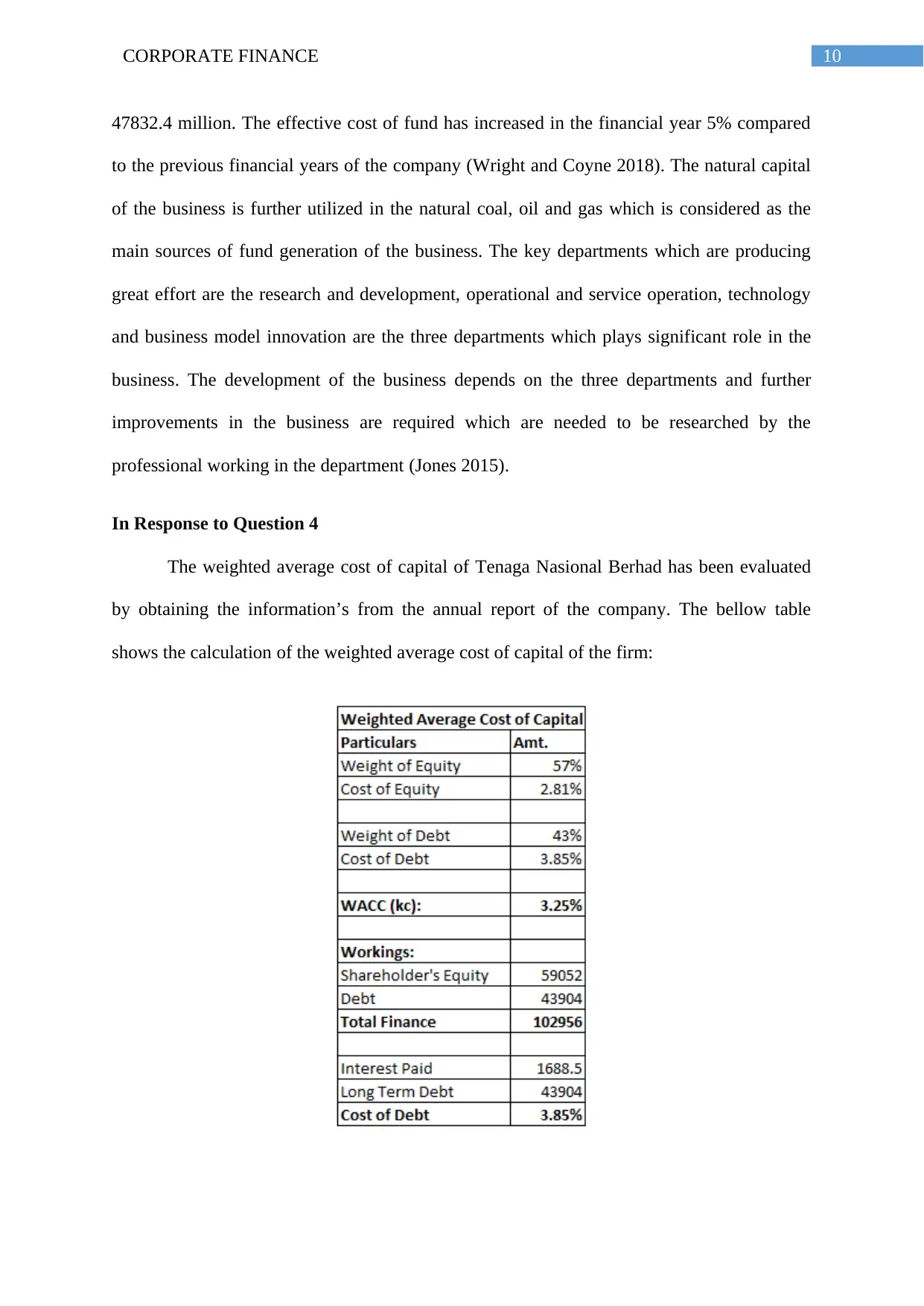
10CORPORATE FINANCE
47832.4 million. The effective cost of fund has increased in the financial year 5% compared
to the previous financial years of the company (Wright and Coyne 2018). The natural capital
of the business is further utilized in the natural coal, oil and gas which is considered as the
main sources of fund generation of the business. The key departments which are producing
great effort are the research and development, operational and service operation, technology
and business model innovation are the three departments which plays significant role in the
business. The development of the business depends on the three departments and further
improvements in the business are required which are needed to be researched by the
professional working in the department (Jones 2015).
In Response to Question 4
The weighted average cost of capital of Tenaga Nasional Berhad has been evaluated
by obtaining the information’s from the annual report of the company. The bellow table
shows the calculation of the weighted average cost of capital of the firm:
47832.4 million. The effective cost of fund has increased in the financial year 5% compared
to the previous financial years of the company (Wright and Coyne 2018). The natural capital
of the business is further utilized in the natural coal, oil and gas which is considered as the
main sources of fund generation of the business. The key departments which are producing
great effort are the research and development, operational and service operation, technology
and business model innovation are the three departments which plays significant role in the
business. The development of the business depends on the three departments and further
improvements in the business are required which are needed to be researched by the
professional working in the department (Jones 2015).
In Response to Question 4
The weighted average cost of capital of Tenaga Nasional Berhad has been evaluated
by obtaining the information’s from the annual report of the company. The bellow table
shows the calculation of the weighted average cost of capital of the firm:
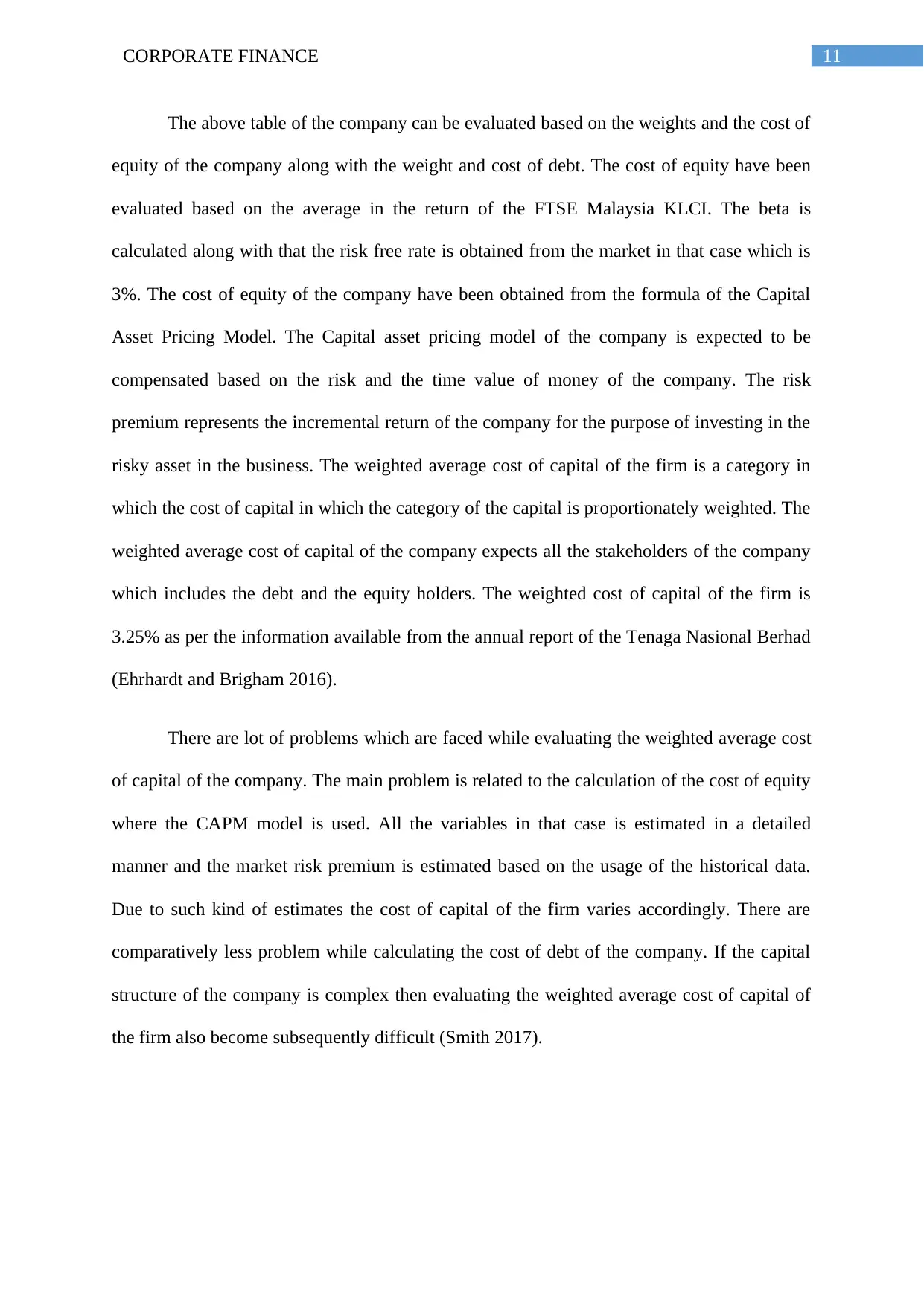
11CORPORATE FINANCE
The above table of the company can be evaluated based on the weights and the cost of
equity of the company along with the weight and cost of debt. The cost of equity have been
evaluated based on the average in the return of the FTSE Malaysia KLCI. The beta is
calculated along with that the risk free rate is obtained from the market in that case which is
3%. The cost of equity of the company have been obtained from the formula of the Capital
Asset Pricing Model. The Capital asset pricing model of the company is expected to be
compensated based on the risk and the time value of money of the company. The risk
premium represents the incremental return of the company for the purpose of investing in the
risky asset in the business. The weighted average cost of capital of the firm is a category in
which the cost of capital in which the category of the capital is proportionately weighted. The
weighted average cost of capital of the company expects all the stakeholders of the company
which includes the debt and the equity holders. The weighted cost of capital of the firm is
3.25% as per the information available from the annual report of the Tenaga Nasional Berhad
(Ehrhardt and Brigham 2016).
There are lot of problems which are faced while evaluating the weighted average cost
of capital of the company. The main problem is related to the calculation of the cost of equity
where the CAPM model is used. All the variables in that case is estimated in a detailed
manner and the market risk premium is estimated based on the usage of the historical data.
Due to such kind of estimates the cost of capital of the firm varies accordingly. There are
comparatively less problem while calculating the cost of debt of the company. If the capital
structure of the company is complex then evaluating the weighted average cost of capital of
the firm also become subsequently difficult (Smith 2017).
The above table of the company can be evaluated based on the weights and the cost of
equity of the company along with the weight and cost of debt. The cost of equity have been
evaluated based on the average in the return of the FTSE Malaysia KLCI. The beta is
calculated along with that the risk free rate is obtained from the market in that case which is
3%. The cost of equity of the company have been obtained from the formula of the Capital
Asset Pricing Model. The Capital asset pricing model of the company is expected to be
compensated based on the risk and the time value of money of the company. The risk
premium represents the incremental return of the company for the purpose of investing in the
risky asset in the business. The weighted average cost of capital of the firm is a category in
which the cost of capital in which the category of the capital is proportionately weighted. The
weighted average cost of capital of the company expects all the stakeholders of the company
which includes the debt and the equity holders. The weighted cost of capital of the firm is
3.25% as per the information available from the annual report of the Tenaga Nasional Berhad
(Ehrhardt and Brigham 2016).
There are lot of problems which are faced while evaluating the weighted average cost
of capital of the company. The main problem is related to the calculation of the cost of equity
where the CAPM model is used. All the variables in that case is estimated in a detailed
manner and the market risk premium is estimated based on the usage of the historical data.
Due to such kind of estimates the cost of capital of the firm varies accordingly. There are
comparatively less problem while calculating the cost of debt of the company. If the capital
structure of the company is complex then evaluating the weighted average cost of capital of
the firm also become subsequently difficult (Smith 2017).
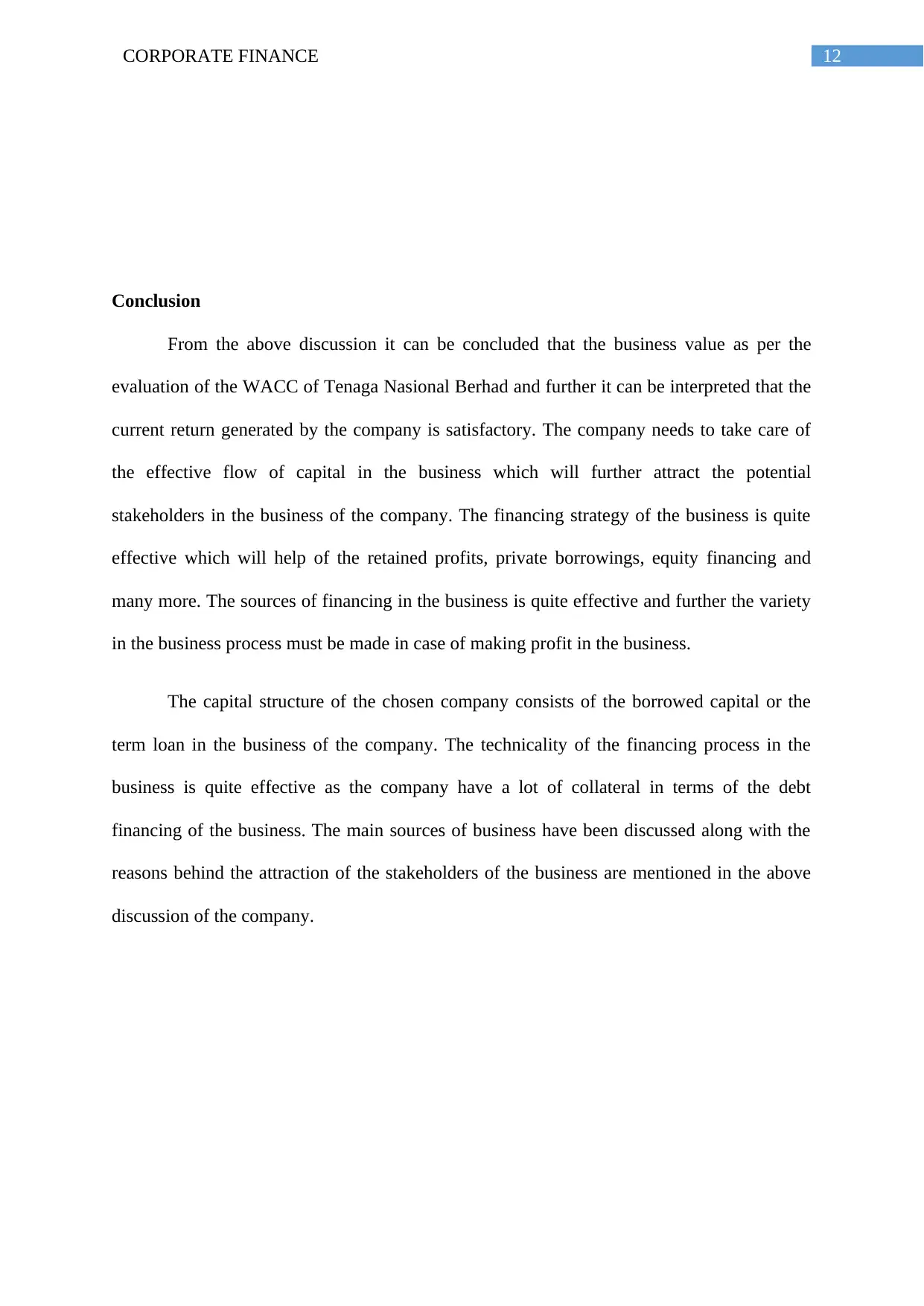
12CORPORATE FINANCE
Conclusion
From the above discussion it can be concluded that the business value as per the
evaluation of the WACC of Tenaga Nasional Berhad and further it can be interpreted that the
current return generated by the company is satisfactory. The company needs to take care of
the effective flow of capital in the business which will further attract the potential
stakeholders in the business of the company. The financing strategy of the business is quite
effective which will help of the retained profits, private borrowings, equity financing and
many more. The sources of financing in the business is quite effective and further the variety
in the business process must be made in case of making profit in the business.
The capital structure of the chosen company consists of the borrowed capital or the
term loan in the business of the company. The technicality of the financing process in the
business is quite effective as the company have a lot of collateral in terms of the debt
financing of the business. The main sources of business have been discussed along with the
reasons behind the attraction of the stakeholders of the business are mentioned in the above
discussion of the company.
Conclusion
From the above discussion it can be concluded that the business value as per the
evaluation of the WACC of Tenaga Nasional Berhad and further it can be interpreted that the
current return generated by the company is satisfactory. The company needs to take care of
the effective flow of capital in the business which will further attract the potential
stakeholders in the business of the company. The financing strategy of the business is quite
effective which will help of the retained profits, private borrowings, equity financing and
many more. The sources of financing in the business is quite effective and further the variety
in the business process must be made in case of making profit in the business.
The capital structure of the chosen company consists of the borrowed capital or the
term loan in the business of the company. The technicality of the financing process in the
business is quite effective as the company have a lot of collateral in terms of the debt
financing of the business. The main sources of business have been discussed along with the
reasons behind the attraction of the stakeholders of the business are mentioned in the above
discussion of the company.
Paraphrase This Document
Need a fresh take? Get an instant paraphrase of this document with our AI Paraphraser
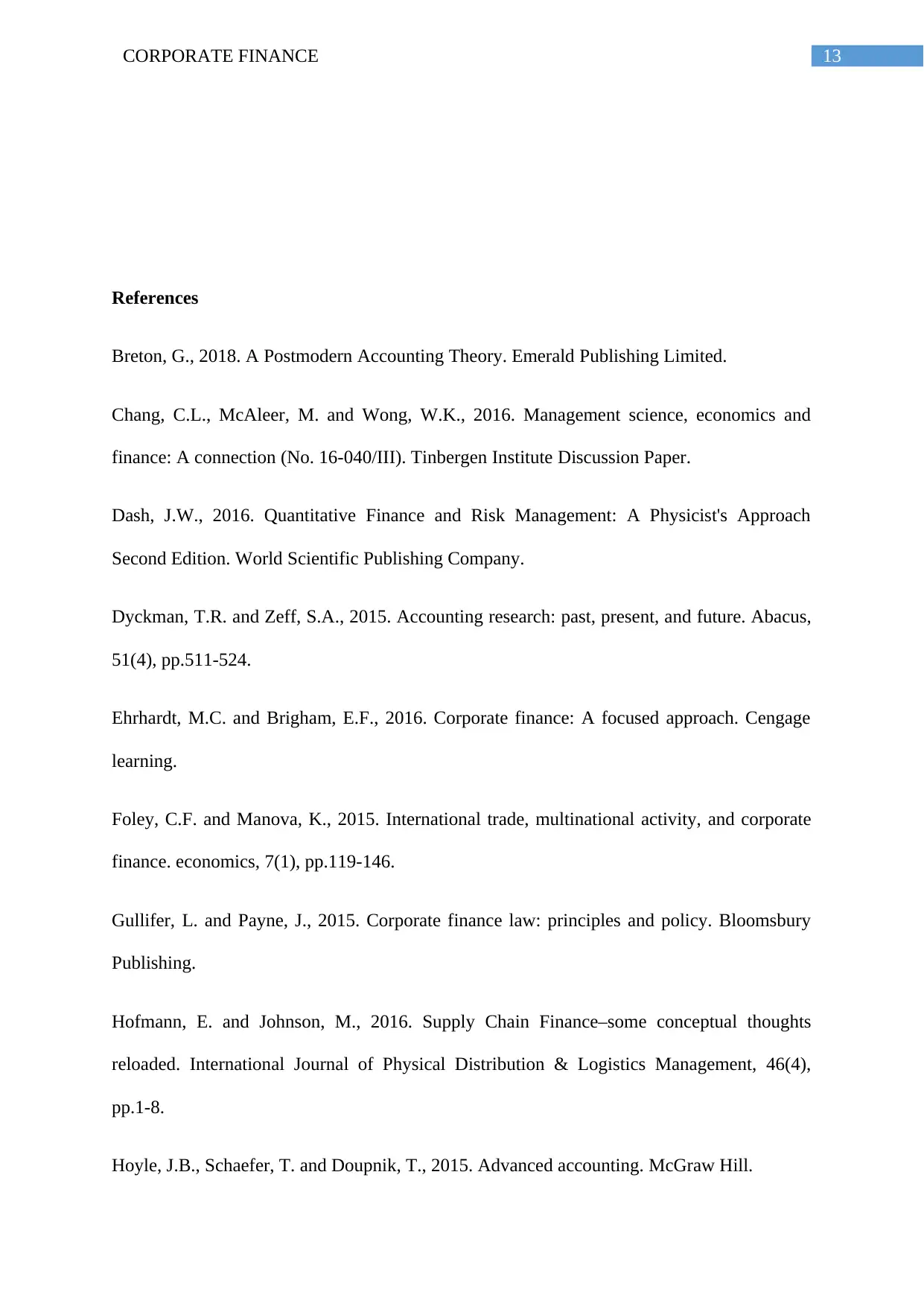
13CORPORATE FINANCE
References
Breton, G., 2018. A Postmodern Accounting Theory. Emerald Publishing Limited.
Chang, C.L., McAleer, M. and Wong, W.K., 2016. Management science, economics and
finance: A connection (No. 16-040/III). Tinbergen Institute Discussion Paper.
Dash, J.W., 2016. Quantitative Finance and Risk Management: A Physicist's Approach
Second Edition. World Scientific Publishing Company.
Dyckman, T.R. and Zeff, S.A., 2015. Accounting research: past, present, and future. Abacus,
51(4), pp.511-524.
Ehrhardt, M.C. and Brigham, E.F., 2016. Corporate finance: A focused approach. Cengage
learning.
Foley, C.F. and Manova, K., 2015. International trade, multinational activity, and corporate
finance. economics, 7(1), pp.119-146.
Gullifer, L. and Payne, J., 2015. Corporate finance law: principles and policy. Bloomsbury
Publishing.
Hofmann, E. and Johnson, M., 2016. Supply Chain Finance–some conceptual thoughts
reloaded. International Journal of Physical Distribution & Logistics Management, 46(4),
pp.1-8.
Hoyle, J.B., Schaefer, T. and Doupnik, T., 2015. Advanced accounting. McGraw Hill.
References
Breton, G., 2018. A Postmodern Accounting Theory. Emerald Publishing Limited.
Chang, C.L., McAleer, M. and Wong, W.K., 2016. Management science, economics and
finance: A connection (No. 16-040/III). Tinbergen Institute Discussion Paper.
Dash, J.W., 2016. Quantitative Finance and Risk Management: A Physicist's Approach
Second Edition. World Scientific Publishing Company.
Dyckman, T.R. and Zeff, S.A., 2015. Accounting research: past, present, and future. Abacus,
51(4), pp.511-524.
Ehrhardt, M.C. and Brigham, E.F., 2016. Corporate finance: A focused approach. Cengage
learning.
Foley, C.F. and Manova, K., 2015. International trade, multinational activity, and corporate
finance. economics, 7(1), pp.119-146.
Gullifer, L. and Payne, J., 2015. Corporate finance law: principles and policy. Bloomsbury
Publishing.
Hofmann, E. and Johnson, M., 2016. Supply Chain Finance–some conceptual thoughts
reloaded. International Journal of Physical Distribution & Logistics Management, 46(4),
pp.1-8.
Hoyle, J.B., Schaefer, T. and Doupnik, T., 2015. Advanced accounting. McGraw Hill.
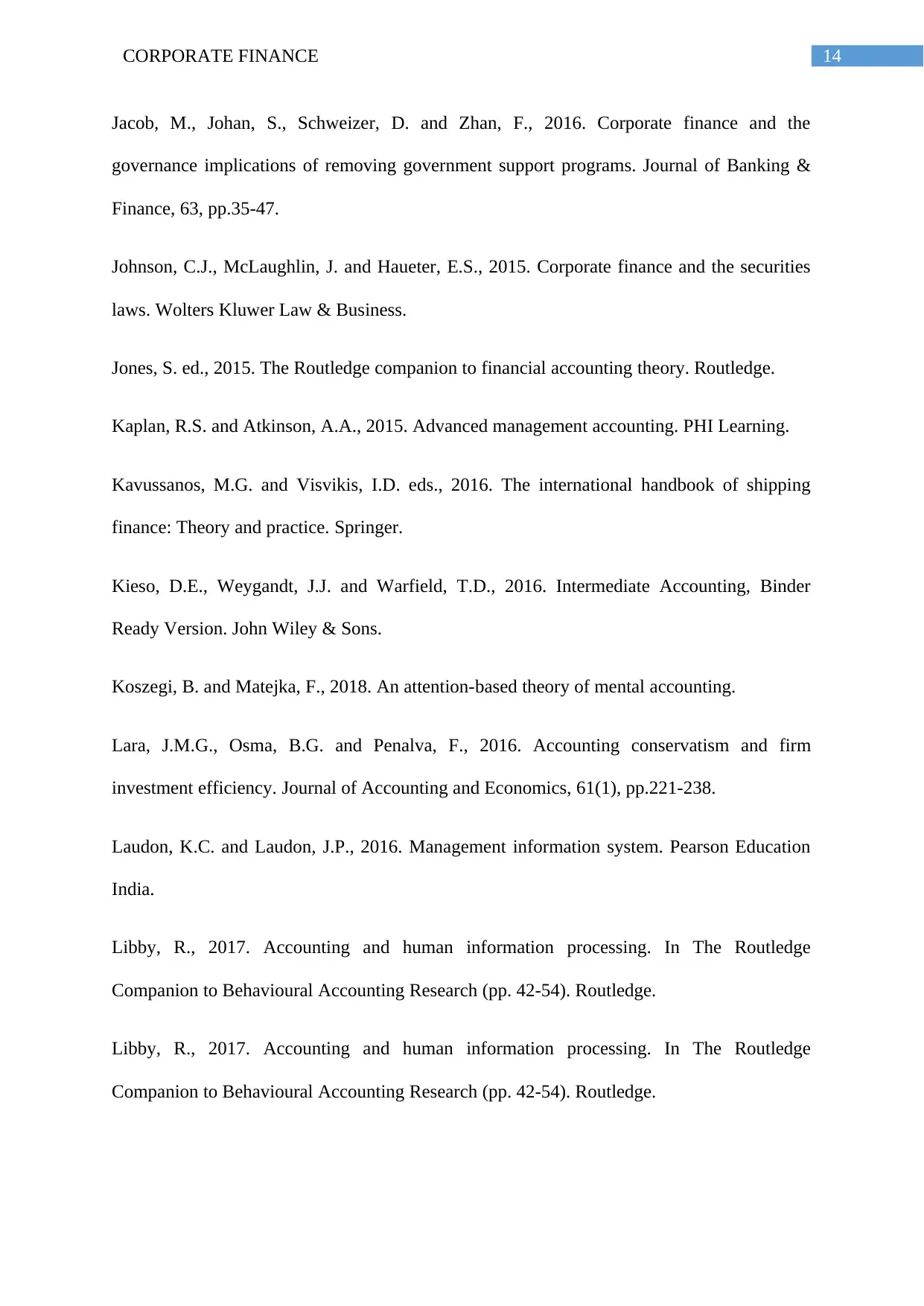
14CORPORATE FINANCE
Jacob, M., Johan, S., Schweizer, D. and Zhan, F., 2016. Corporate finance and the
governance implications of removing government support programs. Journal of Banking &
Finance, 63, pp.35-47.
Johnson, C.J., McLaughlin, J. and Haueter, E.S., 2015. Corporate finance and the securities
laws. Wolters Kluwer Law & Business.
Jones, S. ed., 2015. The Routledge companion to financial accounting theory. Routledge.
Kaplan, R.S. and Atkinson, A.A., 2015. Advanced management accounting. PHI Learning.
Kavussanos, M.G. and Visvikis, I.D. eds., 2016. The international handbook of shipping
finance: Theory and practice. Springer.
Kieso, D.E., Weygandt, J.J. and Warfield, T.D., 2016. Intermediate Accounting, Binder
Ready Version. John Wiley & Sons.
Koszegi, B. and Matejka, F., 2018. An attention-based theory of mental accounting.
Lara, J.M.G., Osma, B.G. and Penalva, F., 2016. Accounting conservatism and firm
investment efficiency. Journal of Accounting and Economics, 61(1), pp.221-238.
Laudon, K.C. and Laudon, J.P., 2016. Management information system. Pearson Education
India.
Libby, R., 2017. Accounting and human information processing. In The Routledge
Companion to Behavioural Accounting Research (pp. 42-54). Routledge.
Libby, R., 2017. Accounting and human information processing. In The Routledge
Companion to Behavioural Accounting Research (pp. 42-54). Routledge.
Jacob, M., Johan, S., Schweizer, D. and Zhan, F., 2016. Corporate finance and the
governance implications of removing government support programs. Journal of Banking &
Finance, 63, pp.35-47.
Johnson, C.J., McLaughlin, J. and Haueter, E.S., 2015. Corporate finance and the securities
laws. Wolters Kluwer Law & Business.
Jones, S. ed., 2015. The Routledge companion to financial accounting theory. Routledge.
Kaplan, R.S. and Atkinson, A.A., 2015. Advanced management accounting. PHI Learning.
Kavussanos, M.G. and Visvikis, I.D. eds., 2016. The international handbook of shipping
finance: Theory and practice. Springer.
Kieso, D.E., Weygandt, J.J. and Warfield, T.D., 2016. Intermediate Accounting, Binder
Ready Version. John Wiley & Sons.
Koszegi, B. and Matejka, F., 2018. An attention-based theory of mental accounting.
Lara, J.M.G., Osma, B.G. and Penalva, F., 2016. Accounting conservatism and firm
investment efficiency. Journal of Accounting and Economics, 61(1), pp.221-238.
Laudon, K.C. and Laudon, J.P., 2016. Management information system. Pearson Education
India.
Libby, R., 2017. Accounting and human information processing. In The Routledge
Companion to Behavioural Accounting Research (pp. 42-54). Routledge.
Libby, R., 2017. Accounting and human information processing. In The Routledge
Companion to Behavioural Accounting Research (pp. 42-54). Routledge.
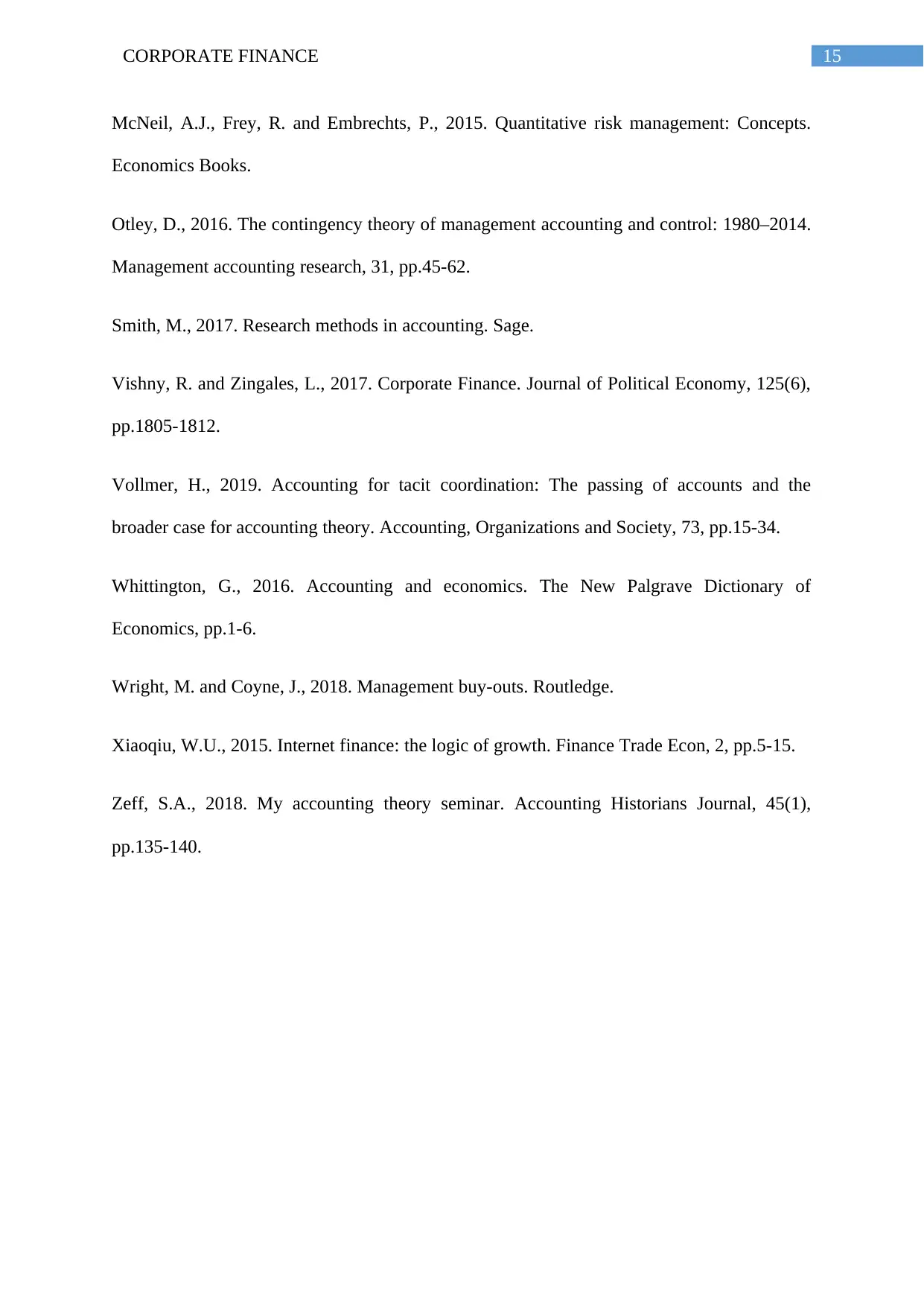
15CORPORATE FINANCE
McNeil, A.J., Frey, R. and Embrechts, P., 2015. Quantitative risk management: Concepts.
Economics Books.
Otley, D., 2016. The contingency theory of management accounting and control: 1980–2014.
Management accounting research, 31, pp.45-62.
Smith, M., 2017. Research methods in accounting. Sage.
Vishny, R. and Zingales, L., 2017. Corporate Finance. Journal of Political Economy, 125(6),
pp.1805-1812.
Vollmer, H., 2019. Accounting for tacit coordination: The passing of accounts and the
broader case for accounting theory. Accounting, Organizations and Society, 73, pp.15-34.
Whittington, G., 2016. Accounting and economics. The New Palgrave Dictionary of
Economics, pp.1-6.
Wright, M. and Coyne, J., 2018. Management buy-outs. Routledge.
Xiaoqiu, W.U., 2015. Internet finance: the logic of growth. Finance Trade Econ, 2, pp.5-15.
Zeff, S.A., 2018. My accounting theory seminar. Accounting Historians Journal, 45(1),
pp.135-140.
McNeil, A.J., Frey, R. and Embrechts, P., 2015. Quantitative risk management: Concepts.
Economics Books.
Otley, D., 2016. The contingency theory of management accounting and control: 1980–2014.
Management accounting research, 31, pp.45-62.
Smith, M., 2017. Research methods in accounting. Sage.
Vishny, R. and Zingales, L., 2017. Corporate Finance. Journal of Political Economy, 125(6),
pp.1805-1812.
Vollmer, H., 2019. Accounting for tacit coordination: The passing of accounts and the
broader case for accounting theory. Accounting, Organizations and Society, 73, pp.15-34.
Whittington, G., 2016. Accounting and economics. The New Palgrave Dictionary of
Economics, pp.1-6.
Wright, M. and Coyne, J., 2018. Management buy-outs. Routledge.
Xiaoqiu, W.U., 2015. Internet finance: the logic of growth. Finance Trade Econ, 2, pp.5-15.
Zeff, S.A., 2018. My accounting theory seminar. Accounting Historians Journal, 45(1),
pp.135-140.
1 out of 16
Related Documents
Your All-in-One AI-Powered Toolkit for Academic Success.
+13062052269
info@desklib.com
Available 24*7 on WhatsApp / Email
![[object Object]](/_next/static/media/star-bottom.7253800d.svg)
Unlock your academic potential
© 2024 | Zucol Services PVT LTD | All rights reserved.





